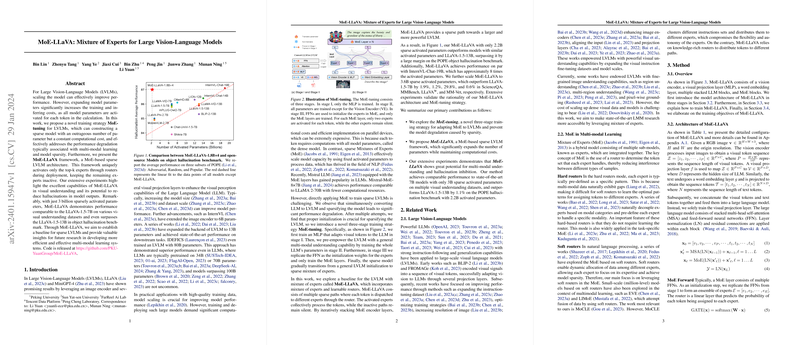Introduction
In the landscape of Large Vision-LLMs (LVLMs), the expansion of model parameters is a common approach to augment model capabilities, but this follows an increased computational burden during training and deployment. Dense models, where each token computation engages all model parameters, exacerbate this issue. Conversely, the Mixture of Experts (MoE) approach has exhibited success in scaling model capacity with fixed computational costs, particularly in the field of NLP.
Methodology: MoE-LLaVA and MoE-tuning
The paper introduces MoE-LLaVA, a framework for sparse LVLMs that leverages an MoE architecture with carefully engineered routers to selectively activate only the top-k experts. This unique configuration enables the maintenance of a constant computational cost while significantly expanding the model's parameter number. The framework consists of a vision encoder, visual projection layer, word embedding layer, LLM blocks, and sparse MoE blocks. The MoE-tuning strategy employs a novel three-stage training process to adapt MoE to LVLMs without performance degradation typically caused by model sparsity.
Experimental Results
Extensive experimentation validates the efficacy of MoE-LLaVA. When benchmarked against multiple visual understanding datasets, models with an unreasonably small parameter count of 3 billion—activated only sparsely—rivaled the performance of LLaVA models with up to 7 billion parameters. The authors establish that MoE-LLaVA delivers performance equivalent to dense LVLMs while requiring fewer computational resources, thus marking a significant contribution towards efficient multi-modal learning.
Contributions and Implications
The primary contributions are multifold:
- The innovation of MoE-tuning methodology for adapting MoE to LVLMs, which prevents degradation due to sparsity.
- The establishment of MoE-LLaVA, a pioneering framework for sparse LVLMs, which allows for substantial model size without proportional increases in computational demands.
- The demonstration through experiments that MoE-LLaVA possesses superior capabilities in multi-modal understanding and exhibits an impressive restraint on hallucination — it outpaces 13-billion-parameter models using only 3 billion sparsely activated parameters.
In theory, MoE-LLaVA has set a new precedent for developing scalable and efficient LVLMs. Results indicate that the paper's contributions could redefine model scaling paradigms, presenting a model that effectively navigates the trade-off between size, performance, and computational cost, which remains a critical challenge in AI research. Future research could expand upon these findings to include a wider array of multi-modal tasks and larger MoE-based LVLMs provided that adequate data pipelines are established.
